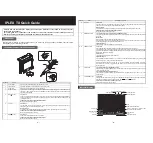
Page 19
With either or both 2ND and 3RD HAR MONIC tab down, the
harmonic drawbar wires are connected to the green signal input
wire of the percussion amplifier. Either or both signals are fed back
to their respective drawbars by resistors R410 and R411 which are
shorted out when the percussion tabs are not in use.
The percussion signals as well as the signals from the vibrato and
phase shift amplifier are combined in the input circuit of cathode
follower V1 and are sent to the expression control, which is also
connected to the input of the reverberation and power amplifier.
2–5 REVERBERATION AND POWER AMPLIFIER
)
The combined signal, from both prior mentioned amplifiers (after
the expression control has acted upon them) are impressed on
the grid of V6 and in turn on V7, the reverberation drive tube. After
passing through the reverberation unit the signal is again amplified
by V6 and passed through a resistive network, components of
which are variable, permitting the reverberation to be available in
several intensities and “off”. From the input of V7 (the reverberation
drive tube) a signal is shunted around the reverberation unit
and its control features which provide a path for the non -
-reverberation signal. The input or V8 receives this signal as well
as a reverberative signal. This common input line also contains the
VOLUME SOFT tab circuitry.
The output of the second half of V8 is a phase inverter driving
push-pull output tubes V9 and V10. A feedback circuit from the
output transformer secondary (R336 and R337) makes the pedal
response more uniform by reducing speaker resonance R336 is
adjusted at the factory
2–6 POWER SUPPLY
)
The power supply uses a 5U4 rectifier tube with conventional
filtering circuit.
2–7 L–100A PERCUSSION VOICING CIRCUITRY
)
2–7–1 MODE SWITCH
With the “Mode Switch’” in any of the reiteration positions, the
harmonics necessary to produce the “Chime”, ‘”Guitar”. and
“Banjo” are all fed into the “A” reiteration channel only, while the
“Marimba” and “Xylophone” effects feed harmonics into both the
“A” and “B” channels. This split into the “A” and “B” channels only
occurs with the use of reiteration. Without reiteration, all effects
are routed into the regular percussion system. The two reiteration
channels are identical.
You will note that a field-effect transistor is located across the
secondary windings of the two input trans formers. These gates—
Q100 and Q303—are fed alternating pulses from a bistable multi-
vibrator which supplies alternate pulses to each one of these gates.
While one is on, the other is off. These gates shunt the signal to
ground, thereby making the channel inoperative. These individual
signals are further amplified by a one stage transistor amplifier,
Q301 for the “A” channel and Q302 for the “ B” channel. They are
then mixed together and fed to a common amplifier, Q307, which
in turn feeds this percussion signal to the input side of the swell
pedal.
The multi-vibrator which supplies the keying pulse for these two
gates does not run continually, but rather is turned off and on each
time a key is depressed on the upper manual. The multi-vibrator
consists of Q305 and Q306. The multi-vibrator rate varies with the
applied base voltage. This voltage is applied through the “Mode
Switch” and R684 and R685. Q304 provides the necessary switch
pulse to start the multi-vibrator.
NOTE 2–7–A
Whenever the reiteration is used, it completely bypasses the percus-
sion section of the AO–42 amplifier.
Содержание L-100 Series
Страница 1: ......
Страница 6: ......
Страница 9: ...Page 9 Figure 1 4 Block Diagram L 100 Series Figure 1 5 Typical Tone Generator...
Страница 38: ...Page 38 This page intentionally left blank...
Страница 40: ...Page 40 Figure 5 3 Schematic Diagram L 100A Percussion Unit Figure 5 3A Parts Layout L 100A Percussion Unit...
Страница 44: ...Page 44 Figure 5 7 Wiring Diagram L 100 Organ...
Страница 45: ...Page 45 Figure 5 8 Wiring Diagram L100 1 and L 100 2 Organs...
Страница 46: ...Page 46 Figure 5 9 Wiring Diagram L 200 Organ...
Страница 49: ...Page 49 Figure 5 13 Parts Layout AO 41 Vibrato Amplifier...
Страница 50: ...Page 50 Figure 5 14 Parts Layout AO 47 126 000023 Vibrato Amplifier...
Страница 51: ...Page 51 Figure 5 14A Comparison Between AO 41 and AO 47 Vibrato Amplifiers...
Страница 52: ...Page 52 Figure 5 15 Parts Layout AO 42 117 000019 Percussion Amplifier...
Страница 53: ...Page 53 Figure 5 16 Parts Layout AO 43 126 000017 Power Amplifier...
Страница 54: ...Page 54 Figure 5 17 Power Amplifier Fuse Location Canadian 101 000130...
















































